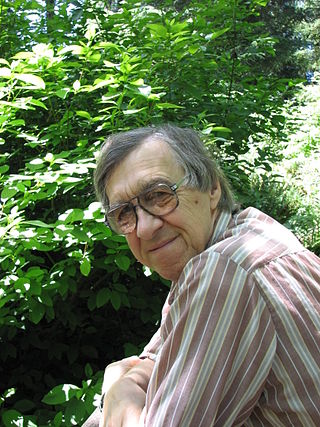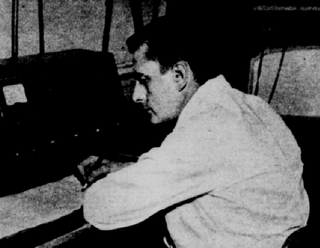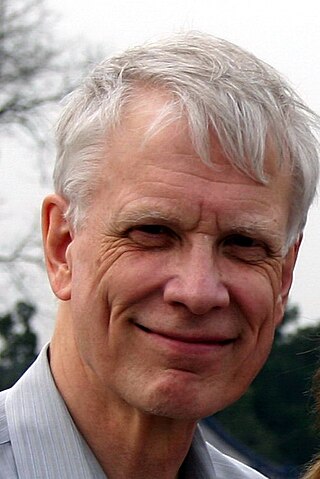Related Research Articles

The Intel 80188 microprocessor was a variant of the Intel 80186. The 80188 had an 8-bit external data bus instead of the 16-bit bus of the 80186; this made it less expensive to connect to peripherals. The 16-bit registers and the one megabyte address range were unchanged, however. It had a throughput of 1 million instructions per second. Intel second sourced this microprocessor to Fujitsu Limited around 1985. Both packages of Intel 80188 version were available in 68-pin PLCC and PGA in sampling at third quarter of 1985.

Parapsychology is the study of alleged psychic phenomena and other paranormal claims, for example, those related to near-death experiences, synchronicity, apparitional experiences, etc. Criticized as being a pseudoscience, the majority of mainstream scientists reject it. Parapsychology has also been criticised by mainstream critics for claims by many of its practitioners that their studies are plausible despite a lack of convincing evidence after more than a century of research for the existence of any psychic phenomena.

A ganzfeld experiment is an assessment used by parapsychologists that they contend can test for extrasensory perception (ESP) or telepathy. In these experiments, a "sender" attempts to mentally transmit an image to a "receiver" who is in a state of sensory deprivation. The receiver is normally asked to choose between a limited number of options for what the transmission was supposed to be and parapsychologists who propose that such telepathy is possible argue that rates of success above the expectation from randomness are evidence for ESP. Consistent, independent replication of ganzfeld experiments has not been achieved, and, in spite of strenuous arguments by parapsychologists to the contrary, there is no validated evidence accepted by the wider scientific community for the existence of any parapsychological phenomena. Ongoing parapsychology research using ganzfeld experiments has been criticized by independent reviewers as having the hallmarks of pseudoscience.

In computing, a hardware random number generator (HRNG) or true random number generator (TRNG) is a device that generates random numbers from a physical process, rather than by means of an algorithm. Such devices are often based on microscopic phenomena that generate low-level, statistically random "noise" signals, such as thermal noise, the photoelectric effect, involving a beam splitter, and other quantum phenomena. These stochastic processes are, in theory, completely unpredictable for as long as an equation governing such phenomena is unknown or uncomputable. This is in contrast to the paradigm of pseudo-random number generation commonly implemented in computer programs.
The Institute of Noetic Sciences (IONS) is an American non-profit parapsychological research institute. It was co-founded in 1973 by former astronaut Edgar Mitchell, the sixth man to walk on the Moon, along with investor Paul N. Temple and others interested in purported paranormal phenomena, in order to encourage and conduct research on noetics and human potentials.
In computer science, a deterministic algorithm is an algorithm that, given a particular input, will always produce the same output, with the underlying machine always passing through the same sequence of states. Deterministic algorithms are by far the most studied and familiar kind of algorithm, as well as one of the most practical, since they can be run on real machines efficiently.
Dean Radin investigates phenomena in parapsychology. Following a bachelor and master's degree in electrical engineering and a PhD in educational psychology Radin worked at Bell Labs, as a researcher at Princeton University and the University of Edinburgh, and was a faculty member at University of Nevada, Las Vegas. He then became Chief Scientist at the Institute of Noetic Sciences (IONS) in Petaluma, California, USA, later becoming the president of the Parapsychological Association. He is also co-editor-in-chief of the journal Explore: The Journal of Science and Healing. Radin's ideas and work have been criticized by scientists and philosophers skeptical of paranormal claims. The review of Radin's first book, The Conscious Universe, that appeared in Nature charged that Radin ignored the known hoaxes in the field, made statistical errors and ignored plausible non-paranormal explanations for parapsychological data.
Jessica Utts is a parapsychologist and statistics professor at the University of California, Irvine. She is known for her textbooks on statistics and her investigation into remote viewing.
The Princeton Engineering Anomalies Research (PEAR) was a research program at Princeton University that studied parapsychology. Established in 1979 by then Dean of Engineering Robert G. Jahn, PEAR conducted formal studies on two primary subject areas, psychokinesis (PK) and remote viewing. Owing to the controversial nature of the subject matter, the program had a strained relationship with Princeton and was considered by the administration and some faculty to be an embarrassment to the university. Critics suggested that it lacked scientific rigor, used poor methodology, and misused statistics, and characterized it as pseudoscience. PEAR closed in February 2007, being incorporated into the "International Consciousness Research Laboratories" (ICRL).
Roger D. Nelson is an American scientist and researcher and the director of the Global Consciousness Project (GCP), an international, multi-laboratory collaboration founded in 1997 which aimed to study collective consciousness. From 1980 to 2002, he was Coordinator of Research at the Princeton Engineering Anomalies Research (PEAR) laboratory at Princeton University. His professional focus was the study of consciousness and intention and the role of the mind in the physical world. His work integrates science and spirituality, including research that is directly focused on numinous communal experiences.

Charles T. Tart is an American psychologist and parapsychologist known for his psychological work on the nature of consciousness, as one of the founders of the field of transpersonal psychology, and for his research in parapsychology.

SystemVerilog, standardized as IEEE 1800, is a hardware description and hardware verification language used to model, design, simulate, test and implement electronic systems. SystemVerilog is based on Verilog and some extensions, and since 2008, Verilog is now part of the same IEEE standard. It is commonly used in the semiconductor and electronic design industry as an evolution of Verilog.

Random number generation is a process by which, often by means of a random number generator (RNG), a sequence of numbers or symbols that cannot be reasonably predicted better than by random chance is generated. This means that the particular outcome sequence will contain some patterns detectable in hindsight but unpredictable to foresight. True random number generators can be hardware random-number generators (HRNGs), wherein each generation is a function of the current value of a physical environment's attribute that is constantly changing in a manner that is practically impossible to model. This would be in contrast to so-called "random number generations" done by pseudorandom number generators (PRNGs), which generate numbers that only look random but are in fact pre-determined—these generations can be reproduced simply by knowing the state of the PRNG.
Robert George Jahn was an American plasma physicist, Professor of Aerospace Science, and Dean of Engineering at Princeton University. Jahn was also a founder of the Princeton Engineering Anomalies Research Lab (PEAR), a parapsychology research program which ran from 1979 to 2007.

Stanley Krippner is an American psychologist and parapsychologist. He received a B.S. degree from the University of Wisconsin–Madison in 1954 and M.A. (1957) and Ph.D. (1961) degrees from Northwestern University.
Global Orgasm was an action originally scheduled for 22 December 2006 by the author and activist couple of Donna Sheehan and Paul Reffell to coincide with the end of winter solstice. The idea was for participants throughout the world to have an orgasm during this one day while thinking about peace. Based on ideas such as that of the noosphere and the work of the Global Consciousness Project at Princeton, it was thought that such an event would have a "widespread positive effect on human well-being."

The Global Carbon Project (GCP) is an organisation that seeks to quantify global greenhouse gas emissions and their causes. Established in 2001, its projects include global budgets for three dominant greenhouse gases—carbon dioxide, methane, and nitrous oxide —and complementary efforts in urban, regional, cumulative, and negative emissions.

The Society for Scientific Exploration (SSE) is a group committed to studying fringe science. The opinions of the organization in regard to what are the proper limits of scientific exploration are often at odds with those of mainstream science. Critics argue that the SSE is devoted to disreputable ideas far outside the scientific mainstream.

James E. Alcock is a Canadian educator. He has been a Professor of Psychology at York University (Canada) since 1973. Alcock is a noted critic of parapsychology and is a Fellow and Member of the Executive Council for the Committee for Skeptical Inquiry. He is a member of the Editorial Board of The Skeptical Inquirer, and a frequent contributor to the magazine. He has also been a columnist for Humanist Perspectives Magazine. In 1999, a panel of skeptics named him among the two dozen most outstanding skeptics of the 20th century. In May 2004, CSICOP awarded Alcock CSI's highest honor, the In Praise of Reason Award. Alcock is also an amateur magician and is a member of the International Brotherhood of Magicians. As of 2020, he is currently on leave from York University.
RDRAND is an instruction for returning random numbers from an Intel on-chip hardware random number generator which has been seeded by an on-chip entropy source. Intel introduced the feature around 2012, and AMD added support for the instruction in June 2015.
References
- ↑ "| Institute of Noetic Sciences" . Retrieved 2016-07-23.
- 1 2 "Terry Schiavo and the Global Consciousness Project". Skeptic News. 27 April 2005. Retrieved 2008-05-05.[ self-published source ]
- ↑ Larsen, Claus (1 January 2003). "An Evening with Dean Radin". Skeptic Report. Archived from the original on 2009-12-01. Retrieved 2008-05-05.[ self-published source ]
- ↑ Carroll, Robert Todd. "Global consciousness". The Skeptic's Dictionary . Retrieved 2010-01-05.
- 1 2 3 May, E.C.; et al. "Global Consciousness Project: An Independent Analysis of The 11 September 2001 Events" (PDF).[ self-published source ]
- ↑ Carey, Benedict (6 February 2007). "A Princeton lab on ESP plans to close its doors". The New York Times . Retrieved 2007-08-03.
- ↑ Bierman, 1996; Blasband, 2000; Nelson, 1995, 1997; Nelson et al., 1996, 1998a, 1998b; Radin, 1997; Radin et al., 1996.[ full citation needed ]
- ↑ Nelson, Roger; Boesch, Holger; Boller, Emil; Dobyns, York; Houtkooper, Joop; Lettieri, Arnold; Radin, Dean; Russek, Linda; Schwartz, Gary; Wesch, Jerry (1998). "Global Resonance of Consciousness: Princess Diana and Mother Teresa". The Electronic Journal for Anomalous Phenomena. Retrieved 24 December 2015.
- ↑ "The EGG Story". Noosphere.princeton.edu. Retrieved 2010-01-05.[ self-published source ]
- ↑ "GCP Event registry" . Retrieved 2009-10-17.[ self-published source ]
- ↑ "Gathering of a global mind" . Retrieved 2008-03-23.[ self-published source ]
- ↑ Williams, Bryan J. (12 August 2002). "Exploratory Block Analysis of Field Consciousness Effects on Global RNGs on September 11, 2001". Noosphere. Retrieved 2009-10-07.[ self-published source ]
- ↑ "A disturbance in the Force...?". Boundary Institute. December 2001. Archived from the original on 2011-07-17. Retrieved 2009-10-07.[ self-published source ]
- ↑ "September 11, 2001: Exploratory and Contextual Analyses" . Retrieved 2008-07-12.[ self-published source ]
- ↑ Berman, A.S. (6 December 2001). "Did Sept. 11 events refocus global consciousness?". USA Today. Retrieved 2010-01-05.
- ↑ Scargle, Jeffrey D (2002). "Was there evidence of global consciousness on September 11, 2001?" (PDF). Journal of Scientific Exploration. 16 (4): 571–577.[ unreliable source? ]
- ↑ Reed, J.D. (9 March 2003). "So just what makes the Earth move?". The New York Times . Retrieved 2010-01-05.
- ↑ Kizilos, Katherine (28 April 2007). "Mind over matter". The Age . Melbourne. Retrieved 2010-01-05.
- ↑ Matthews, Robert (9 February 2009). "Does mind affect matter?". The National . Abu Dhabi. Archived from the original on 2009-03-15. Retrieved 2010-01-05.
- ↑ Shamah, David (23 December 2008). "Digital World: I have seen the future, and it's on the Web". Jerusalem Post. Retrieved 2009-10-07.[ permanent dead link ]